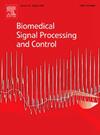Dual-path network with dual-domain fusion and cross-attention for MRI reconstruction
IF 4.9
2区 医学
Q1 ENGINEERING, BIOMEDICAL
引用次数: 0
Abstract
Accelerated magnetic resonance imaging (MRI) involves mapping the under-sampled k-space representation to reconstruct a high-quality image, and it remains a central challenge in MRI reconstruction. In recent years, deep learning has significantly improved the reconstruction performance in MRI. However, there is still a concern in the field regarding how to enhance the global feature learning ability of deep networks to further improve the quality of reconstructed images. To address this issue, this paper proposes a novel MRI reconstruction model called DDFCA-Net, which is based on a dual-path network with dual-domain fusion and cross-attention. The proposed DDFCA-Net model consists of two parallel and interactive paths. One path utilizes a convolutional neural network (CNN) to extract deep features from the k-space domain, while the other path employs a vision transformer (ViT) to extract deep features from the image domain. The image domain features and k-space features are mutually enhanced through cross-fusion. In the proposed model, the ViT network adopts a cross-attention learning strategy. The query matrix is derived from the image domain feature, while both the key matrix and value matrix are obtained from the fusion of the image domain feature and the k-space feature. This cross-attention mechanism promotes effective interaction between the two domains, further enhancing the feature extraction ability. Extensive experimental results on the CC359-Brain and FastMRI single-coil knee datasets, on different sampling rates and strategies, validate the effectiveness of the proposed method. The DDFCA-Net outperforms state-of-the-art methods, demonstrating superior reconstruction performance in MRI.

基于双域融合和交叉关注的双路径网络MRI重建
加速磁共振成像(MRI)涉及映射采样不足的k空间表示来重建高质量的图像,这仍然是MRI重建的核心挑战。近年来,深度学习显著提高了MRI的重建性能。然而,如何增强深度网络的全局特征学习能力,进一步提高重建图像的质量,仍是该领域关注的问题。为了解决这一问题,本文提出了一种新的MRI重建模型DDFCA-Net,该模型基于双域融合和交叉关注的双路径网络。提出的DDFCA-Net模型由两条并行和交互的路径组成。一条路径使用卷积神经网络(CNN)从k空间域中提取深度特征,而另一条路径使用视觉变压器(ViT)从图像域中提取深度特征。图像域特征和k空间特征通过交叉融合相互增强。在该模型中,ViT网络采用了交叉注意学习策略。查询矩阵由图像域特征导出,关键矩阵和值矩阵由图像域特征和k空间特征融合得到。这种交叉注意机制促进了两个领域之间的有效交互,进一步增强了特征提取能力。在CC359-Brain和FastMRI单线圈膝关节数据集上,不同采样率和策略的大量实验结果验证了所提出方法的有效性。DDFCA-Net优于最先进的方法,在MRI中表现出优越的重建性能。
本文章由计算机程序翻译,如有差异,请以英文原文为准。
求助全文
约1分钟内获得全文
求助全文
来源期刊

Biomedical Signal Processing and Control
工程技术-工程:生物医学
CiteScore
9.80
自引率
13.70%
发文量
822
审稿时长
4 months
期刊介绍:
Biomedical Signal Processing and Control aims to provide a cross-disciplinary international forum for the interchange of information on research in the measurement and analysis of signals and images in clinical medicine and the biological sciences. Emphasis is placed on contributions dealing with the practical, applications-led research on the use of methods and devices in clinical diagnosis, patient monitoring and management.
Biomedical Signal Processing and Control reflects the main areas in which these methods are being used and developed at the interface of both engineering and clinical science. The scope of the journal is defined to include relevant review papers, technical notes, short communications and letters. Tutorial papers and special issues will also be published.
 求助内容:
求助内容: 应助结果提醒方式:
应助结果提醒方式:


